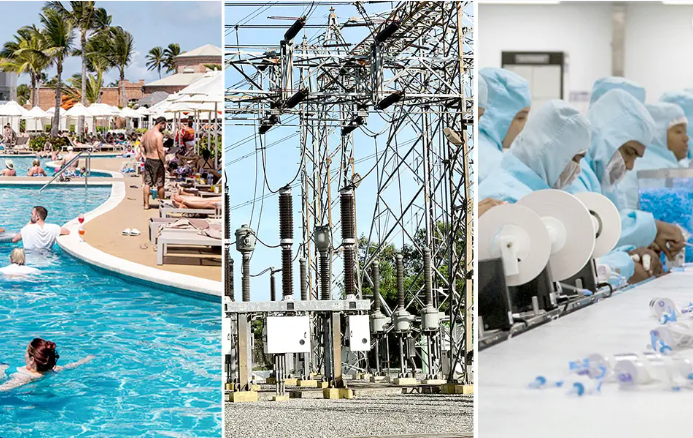
- Tourism Has Been the Main Beneficiary of the Increase, Growing from US$180 Million to US$1.182 Billion
In the past 13 years, the Dominican Republic has seen a notable increase in foreign direct investment (FDI), reflecting the country’s growing appeal to international investors. According to data from the Central Bank of the Dominican Republic (BCRD), total FDI inflows grew from $2.0237 billion in 2010 to $4.3902 billion in 2023, demonstrating robust growth across various economic sectors.
The growth experienced over this period was 116.9%. For 2024, FDI inflows are projected to exceed $4.5 billion. Preliminary figures for the first half of the year show that FDI reached $2.3743 billion, a 0.9% increase compared to the same period last year.
The tourism sector has been the main beneficiary of the rise in FDI in the country. In 2010, tourism investments amounted to $180 million. In 2011, there was a slight drop to $107.8 million. However, the sector recovered in 2012 with $162 million. In 2013, tourism investment grew significantly to $256.5 million.
This growth in what was once known as the “smoke-free industry” continued in 2014, with investments reaching $300.7 million. In 2015, the sector saw an increase, reaching $671.9 million, and in 2016, investments amounted to $790 million. Despite a decrease to $704 million in 2017, the sector rebounded, reaching $854.2 million in 2018. In 2019, tourism investments rose to $994.2 million. Although there was a slight reduction to $954 million in 2020 (the year of the COVID-19 pandemic), the sector recovered in 2021 with $974.6 million and continued its growth in 2022 with $1.0501 billion. In 2023, tourism investment reached $1.1821 billion, reflecting sustained improvement over the years. The Central Bank’s projections indicate that the country is expected to receive around $10.6 billion in tourism revenue (in foreign exchange) in 2024.
This significant increase in tourism highlights growing confidence in the sector. In contrast, commerce and industry showed considerable fluctuations. In 2010, investment totaled $566.1 million but dropped to $355.2 million in 2011. However, in 2012, there was an unexpected increase to $1.2573 billion, followed by a decline in 2013 to $403.7 million.
Despite these fluctuations, the sector saw a significant rebound in 2017 with $1.3652 billion in investment. The following years experienced further fluctuations, with figures dropping to $356.2 million in 2019 but stabilizing and growing to $689.3 million in 2023. The telecommunications sector has been one of the most volatile in terms of foreign investment. In 2010, it received $500.2 million but faced a drastic reduction to $53.6 million in 2011, and then went to -$21.2 million in 2012.
Although there were recoveries in subsequent years, with investments of $256.7 million in 2014 and $335.9 million in 2015, the sector again faced losses in years such as 2016 and 2018. Investment recovered to $312.4 million in 2019 but fell again to -$123.9 million in 2020, ending at -$32.4 million in 2023.
In contrast, the energy sector has shown a trend of steady growth. Investments in energy began at $108.1 million in 2010 and increased significantly over the years. Despite a decrease in 2015 and 2016, the sector rebounded, reaching $430.6 million in 2020 and $1.0711 billion in 2023. This increase indicates growing investment in the energy sector, which has proven to be a key area for the Dominican economy.
Further Details and Another Angle
The financial sector has shown relatively stable investment during the period from 2010 to 2023. In 2010, the sector received $93.5 million in investment. This figure slightly increased to $134.3 million in 2011 and $159.4 million in 2012. In 2013, investment decreased to $152 million but rose again to $207.2 million in 2014.
Starting in 2015, the sector experienced some minor fluctuations: investments dropped to $189.7 million in 2015 and then to $124.6 million in 2016. However, investment increased to $90.9 million in 2017 and $178.7 million in 2018. In 2019, it reduced to $94.3 million, and then to $83.1 million in 2020. Investment in the financial sector showed a recovery in 2021, reaching $115.8 million, and remained relatively stable in 2022 with $172 million. In 2023, investment in the sector ended at $137.3 million, reflecting overall stability despite variations over the period.
Free Zones and Their Yearly Performance
Free zones have grown moderately but steadily. In 2010, investments in free zones were $71.8 million, and although there were fluctuations in subsequent years, such as a peak in 2017 with $263.9 million, the sector continued to grow, reaching $345 million in 2023. This growth reflects the continued attraction of the Dominican Republic as a center for industrial and commercial activities.
The mining sector, known for its volatility, has shown high peaks and declines in investment. With $239.9 million in 2010, the sector peaked at $1.1694 billion in 2012. However, it faced a significant drop in 2014, with negative values, and a partial recovery in subsequent years. In 2023, investment in the mining sector was $278.5 million.
Source:

